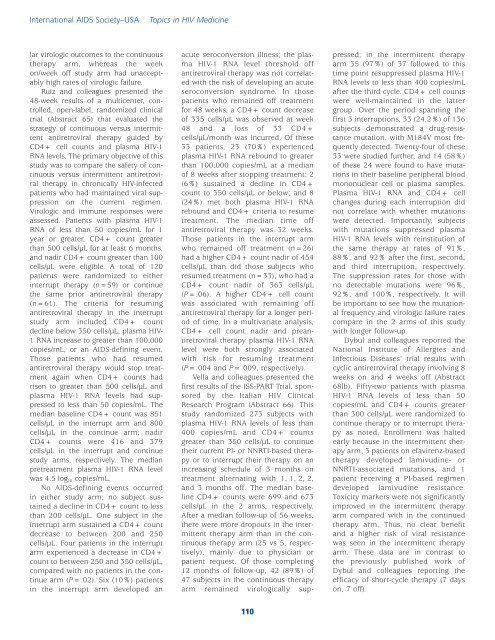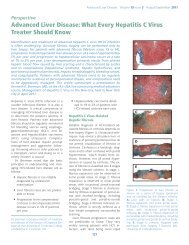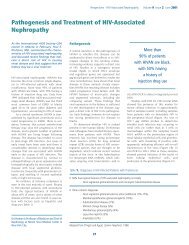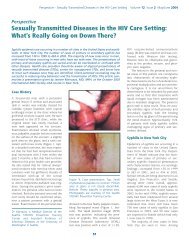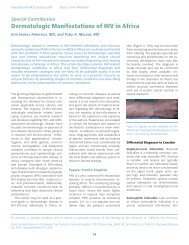Topics in HIV Medicine® - International AIDS Society-USA
Topics in HIV Medicine® - International AIDS Society-USA
Topics in HIV Medicine® - International AIDS Society-USA
Create successful ePaper yourself
Turn your PDF publications into a flip-book with our unique Google optimized e-Paper software.
<strong>International</strong> <strong>AIDS</strong> <strong>Society</strong>–<strong>USA</strong><br />
<strong>Topics</strong> <strong>in</strong> <strong>HIV</strong> Medic<strong>in</strong>e<br />
lar virologic outcomes to the cont<strong>in</strong>uous<br />
therapy arm, whereas the week<br />
on/week off study arm had unacceptably<br />
high rates of virologic failure.<br />
Ruiz and colleagues presented the<br />
48-week results of a multicenter, controlled,<br />
open-label, randomized cl<strong>in</strong>ical<br />
trial (Abstract 65) that evaluated the<br />
strategy of cont<strong>in</strong>uous versus <strong>in</strong>termittent<br />
antiretroviral therapy guided by<br />
CD4+ cell counts and plasma <strong>HIV</strong>-1<br />
RNA levels. The primary objective of this<br />
study was to compare the safety of cont<strong>in</strong>uous<br />
versus <strong>in</strong>termittent antiretroviral<br />
therapy <strong>in</strong> chronically <strong>HIV</strong>-<strong>in</strong>fected<br />
patients who had ma<strong>in</strong>ta<strong>in</strong>ed viral suppression<br />
on the current regimen.<br />
Virologic and immune responses were<br />
assessed. Patients with plasma <strong>HIV</strong>-1<br />
RNA of less than 50 copies/mL for 1<br />
year or greater, CD4+ count greater<br />
than 500 cells/µL for at least 6 months,<br />
and nadir CD4+ count greater than 100<br />
cells/µL were eligible. A total of 120<br />
patients were randomized to either<br />
<strong>in</strong>terrupt therapy (n=59) or cont<strong>in</strong>ue<br />
the same prior antiretroviral therapy<br />
(n=61). The criteria for resum<strong>in</strong>g<br />
antiretroviral therapy <strong>in</strong> the <strong>in</strong>terrupt<br />
study arm <strong>in</strong>cluded CD4+ count<br />
decl<strong>in</strong>e below 350 cells/µL, plasma <strong>HIV</strong>-<br />
1 RNA <strong>in</strong>crease to greater than 100,000<br />
copies/mL, or an <strong>AIDS</strong>-def<strong>in</strong><strong>in</strong>g event.<br />
Those patients who had resumed<br />
antiretroviral therapy would stop treatment<br />
aga<strong>in</strong> when CD4+ counts had<br />
risen to greater than 500 cells/µL and<br />
plasma <strong>HIV</strong>-1 RNA levels had suppressed<br />
to less than 50 copies/mL. The<br />
median basel<strong>in</strong>e CD4+ count was 851<br />
cells/µL <strong>in</strong> the <strong>in</strong>terrupt arm and 800<br />
cells/µL <strong>in</strong> the cont<strong>in</strong>ue arm; nadir<br />
CD4+ counts were 416 and 379<br />
cells/µL <strong>in</strong> the <strong>in</strong>terrupt and cont<strong>in</strong>ue<br />
study arms, respectively. The median<br />
pretreatment plasma <strong>HIV</strong>-1 RNA level<br />
was 4.5 log 10 copies/mL.<br />
No <strong>AIDS</strong>-def<strong>in</strong><strong>in</strong>g events occurred<br />
<strong>in</strong> either study arm; no subject susta<strong>in</strong>ed<br />
a decl<strong>in</strong>e <strong>in</strong> CD4+ count to less<br />
than 200 cells/µL. One subject <strong>in</strong> the<br />
<strong>in</strong>terrupt arm susta<strong>in</strong>ed a CD4+ count<br />
decrease to between 200 and 250<br />
cells/µL. Four patients <strong>in</strong> the <strong>in</strong>terrupt<br />
arm experienced a decrease <strong>in</strong> CD4+<br />
count to between 250 and 350 cells/µL,<br />
compared with no patients <strong>in</strong> the cont<strong>in</strong>ue<br />
arm (P=.02). Six (10%) patients<br />
<strong>in</strong> the <strong>in</strong>terrupt arm developed an<br />
acute seroconversion illness; the plasma<br />
<strong>HIV</strong>-1 RNA level threshold off<br />
antiretroviral therapy was not correlated<br />
with the risk of develop<strong>in</strong>g an acute<br />
seroconversion syndrome. In those<br />
patients who rema<strong>in</strong>ed off treatment<br />
for 48 weeks, a CD4+ count decrease<br />
of 335 cells/µL was observed at week<br />
48 and a loss of 33 CD4+<br />
cells/µL/month was <strong>in</strong>curred. Of these<br />
33 patients, 23 (70%) experienced<br />
plasma <strong>HIV</strong>-1 RNA rebound to greater<br />
than 100,000 copies/mL at a median<br />
of 8 weeks after stopp<strong>in</strong>g treatment; 2<br />
(6%) susta<strong>in</strong>ed a decl<strong>in</strong>e <strong>in</strong> CD4+<br />
count to 350 cells/µL or below; and 8<br />
(24%) met both plasma <strong>HIV</strong>-1 RNA<br />
rebound and CD4+ criteria to resume<br />
treatment. The median time off<br />
antiretroviral therapy was 32 weeks.<br />
Those patients <strong>in</strong> the <strong>in</strong>terrupt arm<br />
who rema<strong>in</strong>ed off treatment (n=26)<br />
had a higher CD4+ count nadir of 454<br />
cells/µL than did those subjects who<br />
resumed treatment (n=33), who had a<br />
CD4+ count nadir of 363 cells/µL<br />
(P=.06). A higher CD4+ cell count<br />
was associated with rema<strong>in</strong><strong>in</strong>g off<br />
antiretroviral therapy for a longer period<br />
of time. In a multivariate analysis,<br />
CD4+ cell count nadir and preantiretroviral<br />
therapy plasma <strong>HIV</strong>-1 RNA<br />
level were both strongly associated<br />
with risk for resum<strong>in</strong>g treatment<br />
(P=.004 and P=.009, respectively).<br />
Vella and colleagues presented the<br />
first results of the ISS-PART Trial, sponsored<br />
by the Italian <strong>HIV</strong> Cl<strong>in</strong>ical<br />
Research Program (Abstract 66). This<br />
study randomized 273 subjects with<br />
plasma <strong>HIV</strong>-1 RNA levels of less than<br />
400 copies/mL and CD4+ counts<br />
greater than 350 cells/µL to cont<strong>in</strong>ue<br />
their current PI- or NNRTI-based therapy<br />
or to <strong>in</strong>terrupt their therapy on an<br />
<strong>in</strong>creas<strong>in</strong>g schedule of 3 months on<br />
treatment alternat<strong>in</strong>g with 1, 1, 2, 2,<br />
and 3 months off. The median basel<strong>in</strong>e<br />
CD4+ counts were 699 and 673<br />
cells/µL <strong>in</strong> the 2 arms, respectively.<br />
After a median follow-up of 56 weeks,<br />
there were more dropouts <strong>in</strong> the <strong>in</strong>termittent<br />
therapy arm than <strong>in</strong> the cont<strong>in</strong>uous<br />
therapy arm (25 vs 5, respectively),<br />
ma<strong>in</strong>ly due to physician or<br />
patient request. Of those complet<strong>in</strong>g<br />
12 months of follow-up, 42 (89%) of<br />
47 subjects <strong>in</strong> the cont<strong>in</strong>uous therapy<br />
arm rema<strong>in</strong>ed virologically suppressed;<br />
<strong>in</strong> the <strong>in</strong>termittent therapy<br />
arm 35 (97%) of 37 followed to this<br />
time po<strong>in</strong>t resuppressed plasma <strong>HIV</strong>-1<br />
RNA levels to less than 400 copies/mL<br />
after the third cycle. CD4+ cell counts<br />
were well-ma<strong>in</strong>ta<strong>in</strong>ed <strong>in</strong> the latter<br />
group. Over the period spann<strong>in</strong>g the<br />
first 3 <strong>in</strong>terruptions, 33 (24.2%) of 136<br />
subjects demonstrated a drug-resistance<br />
mutation, with M184V most frequently<br />
detected. Twenty-four of these<br />
33 were studied further, and 14 (58%)<br />
of these 24 were found to have mutations<br />
<strong>in</strong> their basel<strong>in</strong>e peripheral blood<br />
mononuclear cell or plasma samples.<br />
Plasma <strong>HIV</strong>-1 RNA and CD4+ cell<br />
changes dur<strong>in</strong>g each <strong>in</strong>terruption did<br />
not correlate with whether mutations<br />
were detected. Importantly, subjects<br />
with mutations suppressed plasma<br />
<strong>HIV</strong>-1 RNA levels with re<strong>in</strong>stitution of<br />
the same therapy at rates of 91%,<br />
88%, and 92% after the first, second,<br />
and third <strong>in</strong>terruption, respectively.<br />
The suppression rates for those with<br />
no detectable mutations were 96%,<br />
92%, and 100%, respectively. It will<br />
be important to see how the mutational<br />
frequency and virologic failure rates<br />
compare <strong>in</strong> the 2 arms of this study<br />
with longer follow-up.<br />
Dybul and colleagues reported the<br />
National Institute of Allergies and<br />
Infectious Diseases’ trial results with<br />
cyclic antiretroviral therapy <strong>in</strong>volv<strong>in</strong>g 8<br />
weeks on and 4 weeks off (Abstract<br />
68lb). Fifty-two patients with plasma<br />
<strong>HIV</strong>-1 RNA levels of less than 50<br />
copies/mL and CD4+ counts greater<br />
than 300 cells/µL were randomized to<br />
cont<strong>in</strong>ue therapy or to <strong>in</strong>terrupt therapy<br />
as noted. Enrollment was halted<br />
early because <strong>in</strong> the <strong>in</strong>termittent therapy<br />
arm, 3 patients on efavirenz-based<br />
therapy developed lamivud<strong>in</strong>e- or<br />
NNRTI-associated mutations, and 1<br />
patient receiv<strong>in</strong>g a PI-based regimen<br />
developed lamivud<strong>in</strong>e resistance.<br />
Toxicity markers were not significantly<br />
improved <strong>in</strong> the <strong>in</strong>termittent therapy<br />
arm compared with <strong>in</strong> the cont<strong>in</strong>ued<br />
therapy arm. Thus, no clear benefit<br />
and a higher risk of viral resistance<br />
was seen <strong>in</strong> the <strong>in</strong>termittent therapy<br />
arm. These data are <strong>in</strong> contrast to<br />
the previously published work of<br />
Dybul and colleagues report<strong>in</strong>g the<br />
efficacy of short-cycle therapy (7 days<br />
on, 7 off).<br />
110


